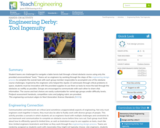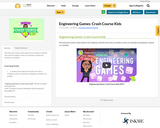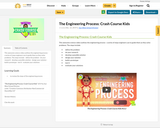
This slideshow offers some great engineering activities that can be done at home using household items. Links included.
- Subject:
- Science
- Material Type:
- Activity/Lab
- Homework/Assignment
- Author:
- Lindsey Nelson
- Date Added:
- 03/25/2020

This slideshow offers some great engineering activities that can be done at home using household items. Links included.

Students extend their knowledge of the skeletal system to biomedical engineering design, specifically the concept of artificial limbs. Students relate the skeleton as a structural system, focusing on the leg as structural necessity. They learn about the design considerations involved in the creation of artificial limbs, including materials and sensors.

Students act as an engineering consulting firm with the task to design and sell their idea for a new vehicle power system. During the brainstorming activity (Generate Ideas), students determine and comprehend what type of information is important to learn in order to accomplish the task. Then they watch several video clips as part of the Multiple Perspectives phase. The new input contributes to changing and focusing their original ideas.

This site offers engineering challenges with things you have at home. Kids learn from taking items from their everyday life and using them in new ways to do simple things. It helps them understand the world around them and how things work.

This week we are looking at renewable energy sources and why we need them. We’ll explore hydropower, wind, geothermal, and solar power, as well as some of the challenges, and how engineers are working to make their use more widespread.

Student teams are challenged to navigate a table tennis ball through a timed obstacle course using only the provided unconventional “tools.” Teams act as engineers by working through the steps of the engineering design process to complete the overall task with each group member responsible to accomplish one of the obstacle course challenges. Inspired by the engineers who helped the Apollo 13 astronauts through critical problems in space, students must be innovative with the provided supplies to use them as tools to move the ball through the obstacles as swiftly as possible. Groups are encouraged to communicate with each other to share vital information. The course and tool choices are easily customizable for varied age groups and/or difficulty levels. Pre/post assessment handouts, competition rules and judging rubric are provided.

Students analyze an assortment of popular inventions to determine whom they are intended to benefit, who has access to them, who might be harmed by them, and who is profiting by them. Then they re-imagine the devices in a way that they believe would do more good for humanity. During the first 90-minute class period, they evaluate and discuss designs in small groups and as a class, examining their decision-making criteria. Collectively, they decide upon a definition of "ethical" that they use going forward. During the second period, students apply their new point-of-view to redesign popular inventions (on paper) and persuasively present them to the class, explaining how they meet the class standards for ethical designs. Two PowerPoint® presentations, a worksheet and grading rubric are provided.

We’ve talked about many important concepts for engineers, but today we’re going to discuss a hugely important one that you might not even realize is an engineering concept: ethics. We’ll talk about what a Code of Ethics is. We’ll explore engineering ethics and the ethical theories of utilitarianism, rights ethics, and duty ethics. We’ll also take a look at a few different real life examples of ethical problems in engineering.

This awesome science video explores how engineers identify and control variables as they are working on designing a solution to a problem.

Students are introduced to genetic techniques such as DNA electrophoresis and imaging technologies used for molecular and DNA structure visualization. In the field of molecular biology and genetics, biomedical engineering plays an increasing role in the development of new medical treatments and discoveries. Engineering applications of nanotechnology such as lab-on-a-chip and deoxyribonucleic acid (DNA) microarrays are used to study the human genome and decode the complex interactions involved in genetic processes.

Under the "The Science Behind Harry Potter" theme, a succession of diverse complex scientific topics are presented to students through direct immersive interaction. Student interest is piqued by the incorporation of popular culture into the classroom via a series of interactive, hands-on Harry Potter/movie-themed lessons and activities. They learn about the basics of acid/base chemistry (invisible ink), genetics and trait prediction (parseltongue trait in families), and force and projectile motion (motion of the thrown remembrall). In each lesson and activity, students are also made aware of the engineering connections to these fields of scientific study.

Students learn about applied forces as they create pop-up-books the art of paper engineering. They also learn the basic steps of the engineering design process.

This awesome science video outlines the engineering process - a series of steps engineers use to guide them as they solve problems. The steps include:
- define the problem
- do your research
- develop a possible solution
- design your solution
- build a prototype
- test it
- evaluate your solutions

Students are introduced to safety protocols by evaluating unsafe situations, sharing their ideas with their peers, developing a list of recommended safety protocols as a class, and finally, by comparing the class list to a standard list of safety rules. This activity seeks to demonstrate the importance of safety engineering and illustrate how it helps to prevent injuries and save lives. A PowerPoint® presentation, pre/post quiz and student handout are provided.

Simple machines are devices with few or no moving parts that make work easier. Students are introduced to the six types of simple machines the wedge, wheel and axle, lever, inclined plane, screw, and pulley in the context of the construction of a pyramid, gaining high-level insights into tools that have been used since ancient times and are still in use today. In two hands-on activities, students begin their own pyramid design by performing materials calculations, and evaluating and selecting a construction site. The six simple machines are examined in more depth in subsequent lessons in this unit.

Students use simple materials to design an open spectrograph so they can calculate the angle light is bent when it passes through a holographic diffraction grating. A holographic diffraction grating acts like a prism, showing the visual components of light. After finding the desired angles, students use what they have learned to design their own spectrograph enclosure.

Students build small-sized prototypes of mountain rescue litters rescue baskets for use in hard-to-get-to places, such as mountainous terrain to evacuate an injured person (modeled by a potato) from the backcountry. Groups design their litters within constraints: they must be stable, lightweight, low-cost, portable and quick to assemble. Students demonstrate their designs in a timed test during which they assemble the litter and transport the rescued person (potato) over a set distance.

Students follow the steps of the engineering design process (EDP) while learning about assistive devices and biomedical engineering. They first go through a design-build-test activity to learn the steps of the cyclical engineering design process. Then, during the three main activities (7 x 55 minutes each) student teams are given a fictional client statement and follow the EDP steps to design products an off-road wheelchair, a portable wheelchair ramp, and an automatic floor sweeper computer program. Students brainstorm ideas, identify suitable materials and demonstrate different methods of representing solutions to their design problems scale drawings or programming descriptions, and simple models or classroom prototypes.

This unit covers the broad spectrum of topics that make-up our very amazing human body. Students are introduced to the space environment and learn the major differences between the environment on Earth and that of outer space. The engineering challenges that arise because of these discrepancies are also discussed. Then, students dive into the different components that make up the human body: muscles, bones and joints, the digestive and circulatory systems, the nervous and endocrine systems, the urinary system, the respiratory system, and finally the immune system. Students learn about the different types of muscles in the human body and the effects of microgravity on muscles. Also, they learn about the skeleton, the number of and types of bones in the body, and how outer space affects astronauts' bones. In the lessons on the digestive, circulatory, nervous and endocrine systems, students learn how these vital system work and the challenges faced by astronauts whose systems are impacted by spaceflight. And lastly, advances in engineering technology are discussed through the lessons on the urinary, respiratory and immune systems while students learn how these systems work with all the other body components to help keep the human body healthy.

Students learn about the periodic table and how pervasive the elements are in our daily lives. After reviewing the table organization and facts about the first 20 elements, they play an element identification game. They also learn that engineers incorporate these elements into the design of new products and processes. Acting as computer and animation engineers, students creatively express their new knowledge by creating a superhero character based on of the elements they now know so well. They will then pair with another superhero and create a dynamic duo out of the two elements, which will represent a molecule.